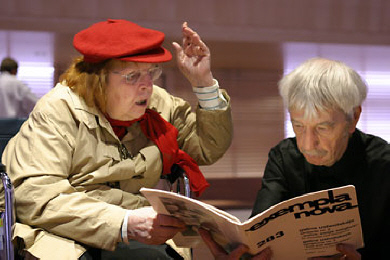|
 Galina Ustvolskaya Galina Ustvolskaya
90th Birthday Celebration
"Reflections on the lady's hammer" - lecture by Rachel Foulds celebrating the 90th anniversary of Galina Ustvolskaya's birth.
Bach Inventions & Sinfonias
Ustvolskaya: 12 Preludes (Nos.1-6 & 9)
Knaifel: 5 Pieces
Ustvolskaya: Grand Duet for Cello and Piano; Trio for Clarinet, Violin and Piano
Elena Nalimova (piano), Alexander Ivashkin (cello), Sarah Thurlow (clarinet), Anna Cashell (violin)
18 June 2009, Council Chamber, Deptford Town Hall
Two Goldsmiths PhD students engaged on Ustvolskaya research made notable contributions to the last week of the college's annual Pure Gold Festival (q.v. Crumb & Schnittke, May 21st) with a rare portrait concert devoted to the controverial St Petersburg composer Galina Ustvolskaya (17 June 1919 - 22 December 2006).
Rachel Foulds ** broadened our perspective by demonstrating that in earlier years Galina Ustvolskaya's idiom was not so austere and ascetic as it later became. She illustrated her talk with examples of the music from the days of her close association with Shostakovich (a difficult relationship which ultimately soured) and she showed us material from newly discovered manuscripts.
Elena Nalimova, a formidable St Petersburg-trained pianist (later RSAMD & RCM in London) played throughout the greatly demanding programme. She gave first a short, concentrated recital which placed Ustvolskaya's Preludes between Bach & Knaifel, four brief contrapuntal early Knaifel pieces followed by his evocative Nativity with (nearly inaudible) bells brushed with her left hand.* All these were given with concentration and, to emphasise the connections over the centuries, without pause between the groups - nor a proper chance for the audience to express appreciation before she was gone...
Nalimova was joined by musicians of high professional calibre in two of Ustvolskaya's major chamber works, and these benefited enormously from live performance heard at close quarters. The high spot was the aptly titled Grand Duet which has a vivid intenisty rare in all music; the partnership with Professor Ivashkin was unforgettable, aggressivity countered by long lines of near stasis.
How often will Ustolvskaya's music get to be heard again before 2056 or 2069, when her publisher might try to renew interest in an unique figure of 20 C music?
Peter Grahame Woolf
* c.p. the dread Chapter Eight, "for church, cello and chorus" Knaifel experience recently...
Further reading:
** Comments on the works played at Deptford; excerpt from Rachel Foulds' thesis in preparation:-
Galina Ustvolskaya, the Znamenny Raspev and the Byzantine Connection
- - her rejection of the church is not absolute as she stated that her predominantly
spiritual compositions ‘are best
suited to performance in a church’.
Symphony Number 2 – “Benedictus Qui Venit” includes a part for an orator
who does not utter any distinguishable words until half way through the work. Instead
a half-beast, half-man outcry is exclaimed: ‘Ay!’ A-y-y-y!’, reminiscent of the
Revelation’s day of judgment, conjuring images of beasts inhabiting the earth at a
time where man is reduced to pleading for God’s mercy. Ustvolskaya’s removal of
text from the cantor’s part portrays a suffering and anguished depiction of Man,
removed from God’s compassion and far from any traditionally absolving Benedictus
qui Venit.
The text to Ustvolskaya’s Symphony Number 5 is the Lord’s Prayer, a prayer that gave
Ustvolskaya constant inspiration for all her life. It therefore seems apt that it was this
text that was used for her 5th Symphony – her definitive symphonic comment.
The work is littered with expressivissimo! and fervido! direction markings. As the
cantor recites: ‘And lead us not into temptation, but deliver us from evil’, the
percussion utters a low ominous roll and the ascertained crotchet pulsation is
transformed to a slower, minim beat, reinforcing the threatening intensity of the text. - -
- - In the Grand Duet for Cello and Piano, numerous rhythmic references to
Russian Orthodox chant can also be identified. Dullaghan suggests that Ustvolskaya
imposed sforzandi and accented articulation marks on each consecutive note in this
example to combat any subjectivity that would arise from a succession of similar
sound impacts at equal time intervals. Indeed, it is very difficult to listen to
successive rhythmic impressions of equal strength and time without personally
imposing a systematic listening strategy. It does appear to the listener, after a brief
passing of time that some notes in the series would stand out with greater potency and
intensity. Sure enough, in keeping with Dullaghan’s assertion, the maximum intensity
and effort on behalf of the performer required for each individual note does remove
any vestige of rhythmic hierarchy and this inferred subjective phenomenon.
Ustvolskaya imposes precautions that leaves no risk that either the performer or the
listener can devise a systematic rhythmic plan. - -
The obsessive crotchet pulse in
Ustvolskaya’s music also has further
resonance in the repetition constantly palpable
in Orthodox ritual.
See also on Musical Pointers:
Ustvolskaya and the piano (1999)
South Bank Festival (2006)
Obituary The Guardian (January 2007)
Picture: Galina Ustvolskaya with Reinbert de Leeuw in Amsterdam
|



